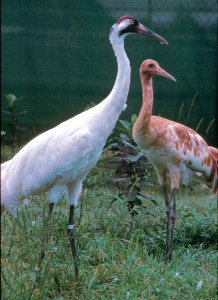by Chester McConnell, WCCA
Worthey D. Wiles, 42, of Dallas, has entered a plea of guilty and was sentenced for killing a whooping crane .Wiles killed the whooping crane on January 12, 2013. The announcement was made by United States Attorney Kenneth Magidson today along with Nick Chavez, special agent in charge of U.S. Fish and Wildlife Service (FWS).
Wiles was a guest hunter at the St. Charles Bay Hunting Club in Rockport which is located inside the designated critical habitat for whooping cranes. While hunting in the marsh adjacent to San Jose Island, Wiles shot and killed a juvenile whooping crane. After contacting Texas Parks and Wildlife (TPW), Wiles told state game wardens he thought the whooping crane was a Sandhill crane. Wardens then contacted FWS who located the bird and verified it was a whooping crane.
Even though Wiles believed he was shooting a Sandhill crane, hunting for them is illegal near San Jose Island where the bird was killed and throughout the whooper’s traditional wintering habitat centered on the Aransas National Wildlife Refuge north of Rockport.
“The whooping crane is one of the most beautiful and highly valued species of America’s wildlife heritage,” said Chavez. FWS is committed to protecting this extraordinary bird so that future generations of Americans are able to marvel at its grace and beauty.”
Wiles, a Dallas duck hunter shot and killed one of the juvenile cranes that had hatched and been reared by its wild parents during the summer of 2012 on Wood Buffalo, Canada nesting grounds. The young whooping crane was one of only 34 produced in Canada in 2012 and was killed during its first visit to the Texas coast. It had successfully completed its first 2,400 mile migration from Canada to Texas. Young whoopers have a potential life span of 40 or more years if they remain healthy. The Whooping Crane Conservation Association asserts that even the loss of one crane from the approximate 300 wild whoopers in the world is a serious tragedy.
Whooping cranes are one of the rarest birds in the world with a total population of approximately 437 cranes in the wild and 599 overall. The whooping crane population that winters in Texas is the only self-sustaining wild population of whooping cranes in the world. This case is only the fifth known shooting death of a whooping crane since 1968. Killing one of the approximate 300 wild whooping cranes that migrate from Canada to Texas is a federal violation of the Endangered Species Act. Punishment spans a broad range of fines, restitution fees and prison terms. Under the federal Endangered Species Act it is a crime to harm, harass or kill a federally-protected species. Violators face fines of up to $250,000 and up to one year in jail.
Today, when Wiles appeared before United States Magistrate Judge B. Janice Ellington, he entered a plea of guilty to one count of violating the Migratory Bird Treaty Act, which provides protection for Migratory Birds. As a result, he was ordered to pay a $5,000 fine and make a $10,000 community service payment to the non-profit organization Friends of Aransas and Matagorda Island National Wildlife Refuges. He will also serve a one-year-term of probation for his conviction. The Whooping Crane Conservation Association stated it is pleased that a $10,000 community service payment is going to Friends of Aransas and Matagorda Island National Wildlife Refuges. The organization performs valuable voluntary services for the refuge.
In a recently settled case, a South Dakota man who shot and killed a whooping crane was ordered to pay $85,000 in restitution and serve two years’ probation. He was also required to surrender his firearms used in the offense and will lose his fishing, hunting and trapping privileges anywhere in the United States for two years and pay a $25 assessment to the Victim Assistance Fund. A Whooping Crane Conservation Association spokesman said restitution should be a minimum of $150,000 based on the amount of time, effort, research, land costs, law enforcement and other expense that goes into nurturing and protecting these iconic birds. Likewise, the Association believes jail time should be imposed on violators to let it be known that such crimes are serious.
The Aransas County death is the fifth known Texas case involving the shooting of a whooping crane since 1968, though another crane death in Calhoun County remains under investigation. Previous Texas cases from 1989 and 1991 ended in fines totaling $21,000 and $23,100 respectively.


